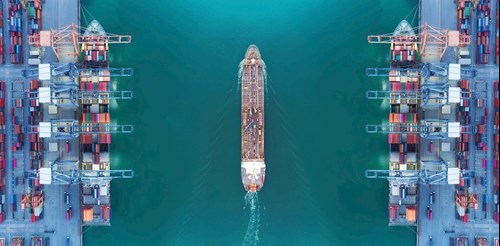Maximising port fire safety
 Material handling machines operating in a port
Material handling machines operating in a portAs 24/7 operation helps operators to keep pace with rising demand, and new technological innovations help to improve efficiency, ports across the globe are seeing an increase in fire safety risks. What are your obligations? There is a need for industry-specific legislation in the ports industry to guide operators through the evolving risks, ensuring maximum safety and minimal downtime. The standard health and safety laws (HSW Act (1974) and Management of Health and Safety at Work Regulations (1999) apply, however there is no port-specific, mandatory legislation to guide protection measures against rising fire risks. The HSE’s Approved Code of Practice, ‘Safety in Docks’ supports those in the industry who have a legal obligation to comply with the relevant standard health and safety laws mentioned above. However, it doesn’t fully address all issues associated with health and safety at docks and ports. The Port Marine Safety Code (2016), developed by the Department of Transport, is an optional standard for port operators to follow, but at present there is no global, mandatory standard for port safety. Mandatory global standards – which can regulate the port industry’s evolving fire safety risks – would give better clarity and a well-defined, comprehensive list of standards that can be applied throughout ports and docks worldwide. Evolving fire safety risks The shift from manual operations to machine-led processes through global automation and electrification of vehicles is optimising productivity and efficiency across ports. However, it’s also affecting the industry’s fire risks: The pandemic accelerated the port industry’s adoption of automated vehicles, as it allowed operations to continue, with workers keeping a safe distance from one another, and it also improved cost-efficiency. However, with less people close to operating vehicles on site at any one time, it’s becoming more complex to detect fire risks. Where manual fire detection systems are in operation alongside automated vehicles, delays in suppression agents being released can occur, as they rely on the vehicle communicating with the operator, and the operator responding and administering the suppression agent to remove the risk. Batteries are increasingly being applied as a more sustainable fuel source across the globe. This is affecting the number of electric vehicles and machinery onsite at ports, but it’s also affecting the quantity of lithium-ion (li-ion) batteries being transported across ports. Electrification presents new and unique fire risks, as the li-ion batteries underpinning the transition to electric ‘fuel’ are at risk of ‘thermal runaway’. This is where a fault in the battery’s cells – caused by overvoltage, overheating, overcharging or physical damage – leads to rapid increases in temperature, resulting in fire, toxic gas emissions and potential explosions. Recent fires that emerged earlier this year reflect the real risks posed by electrification for ports. Strengthening safety at ports Port risks continue to evolve, and to keep pace with recent changes, port operators can maximise safety, firstly by carrying out regular reviews of existing risks assessments across their site and modifying them as and when appropriate. Modification of existing protocols can include assessing associated risks of any new vehicles, machinery and processes being introduced to the site, along with any sudden risks due to delays in materials handling, for example. For automation and electrification, there are additional measures to consider to minimise operational downtime in case of a fire and to maximise safety: A holistic approach to fire safety at ports Considering your site as a whole will inform comprehensive risk assessments that will ensure effective fire safety. For instance, your site’s fire suppression solution should address older risks arising from the protection of traditional combustion vehicles in addition to new, evolving risks. As well as your site’s fire detection and suppression solution, there are other steps to take to ensure your site is safe. For example, you need to train key personnel, so they know how to safely use the system and act in the event of a fire. This will maximise their safety and your overall site’s safety For further information on how you can best protect your port against evolving fire risks, get in touch.

About Dafo Vehicle
Dafo was founded in 1919 and has developed into a modern, high-tech company committed to offer the very best solutions to its customers. Dafo was one of the first companies in the world which started to develop integrated firefighting solutions for vehicles back in 1976. Dafo Vehicle Fire Protection has three main business areas: Integration (Fire suppression systems integration into OEM production line, Retrofit (Fire suppression systems installed at final customer) as well as Service & Maintenance. The Dafo Vehicle group today consist of several subsidiaries and Dafo dealers – Dafo Vehicle Oy (Finland), Dafo US, Dafo Deutschland, Dafo Russia, Dafo Asia, Dafo Spain, Dafo UK & Ireland, Dafo Middle East, Dafo Chile, Dafo Brasil, Dafo Australia and Dafo Peru. The head office is located in Tyresö, Sweden.